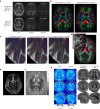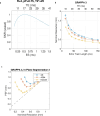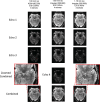Next-generation MRI scanner designed for ultra-high-resolution human brain imaging at 7 Tesla
- PMID: 38012321
- PMCID: PMC10703687
- DOI: 10.1038/s41592-023-02068-7
Next-generation MRI scanner designed for ultra-high-resolution human brain imaging at 7 Tesla
Abstract
To increase granularity in human neuroimaging science, we designed and built a next-generation 7 Tesla magnetic resonance imaging scanner to reach ultra-high resolution by implementing several advances in hardware. To improve spatial encoding and increase the image signal-to-noise ratio, we developed a head-only asymmetric gradient coil (200 mT m-1, 900 T m-1s-1) with an additional third layer of windings. We integrated a 128-channel receiver system with 64- and 96-channel receiver coil arrays to boost signal in the cerebral cortex while reducing g-factor noise to enable higher accelerations. A 16-channel transmit system reduced power deposition and improved image uniformity. The scanner routinely performs functional imaging studies at 0.35-0.45 mm isotropic spatial resolution to reveal cortical layer functional activity, achieves high angular resolution in diffusion imaging and reduces acquisition time for both functional and structural imaging.
© 2023. The Author(s).
Conflict of interest statement
A.P., I.G.-I., S.S., E.R. and P.D. are employees of Siemens Healthineers. S.M. and P.B. are employees of Siemens Medical Solutions USA, Inc. S.G. is an employee of MR CoilTech Limited, LLC. A.J.S.B. and D.A.F. are employees of Advanced MRI Technologies. D.A.F. has equity in Advanced MRI Technologies. L.W. has consulting and equity with Neuro42 Inc., a low-field MRI start-up company, research support from Siemens Healthineers, equity in Reveal Pharmaceuticals, an MR contrast agent start-up, and patents related to MRI assigned to MGH that have been licensed and/or could be potentially licensed. M.D. has consulting with Neuro42 Inc.
Figures














References
MeSH terms
Grants and funding
LinkOut - more resources
Full Text Sources
Medical
Research Materials
Miscellaneous

